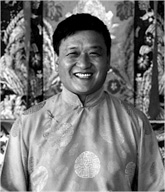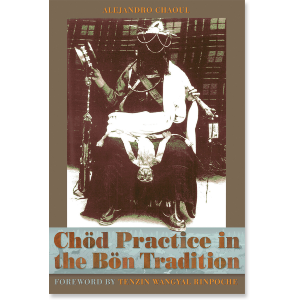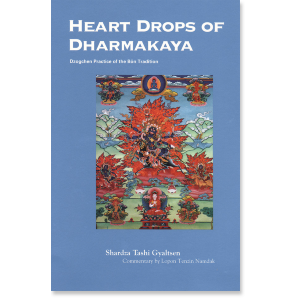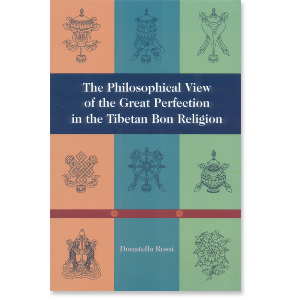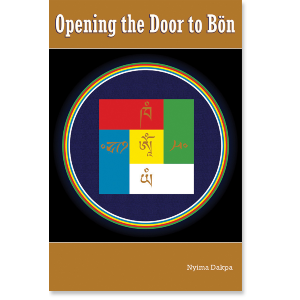| The following article is from the Summer, 1991 issue of the Snow Lion Newsletter and is for historical reference only. You can see this in context of the original newsletter here. |
Lopon Tenzin Namdak
by Tuula Saarikoski
Lopon Tenzin Namdak is the principal Master of the Bon monastery at Dolanji, India. He is a Dzogchen Master who transmits the most ancient Dzogchen teachings of Shang-Shung. He has also been actively responsible for the Bonpo refugees of Tibet, organizing for them a prospering settlement at Dolanji. Thanks to his efforts, a new location for Tibet's old Menri Monastery has been established.
1927: Bon family, Eastern Tibet
Tenzin Namdak was born to a Bon family at Chungpo Karu, near Chamdo in Eastern Tibet, in 1927. At the age of five he left his parents' house to study with his uncle, who lived in the same village.

With his first main master, Gonruponlob, Tenzin Namdak spent six years on a small island studying grammar, astrology, poetry and Sanskrit. The master and his young student were the only inhabitants of the island.
Part of the intense process of his education involved the boy having to find his own nourishment with the result that he was hungry most of the time. When I become a master and have disciples, I shall give them food, he then decided.
Menri Monastery
I left my own country and came to Menri Monastery when I was fifteen, Lopon Namdak recalls. Menri Monastery in Tsang near Shigatse was the most important Bonpo monastery in all Tibet. The name of the monastery, Menri, means medicine mountain.
It was after finishing his early studies on the island that he arrived at Menri Monastery. He then made a pilgrimage to Mount Kailash, from where he once again returned to Menri. There Tenzin Namdak continued his education under the guidance of the Menri Lopon Sangye Tenzin, his principal master and his predecessor as the main master of the monastery.
Tenzin Namdak spent six years on a small island studying grammar, astrology, poetry and Sanskrit. The master and his young student were the only in-habitants of the island.
When he had finished his formal studies of philosophy, logic, Vinaya, cosmology and the Prajnaparamita, he also completed studies of the Tantric and Dzogchen systems. He finished the studies for the geshe degree and at the age of thirty was approved by all the teachers of the monastery to be the new Lopon, or principal teacher of Menri.
Preserving the Bön Tradition of Tibet
Lopon Namdak escaped from Tibet in the notorious year of 1959, together with forty monks of Menri Monastery. Only half of the monks survived the difficult and dangerous journey over the mountains to Nepal.
In Kathmandu, Lopon Namdak met David Snellgrove, a Tibetologist from London University who at that time was studying Bon traditions and culture. Together with two other Bonpo lamas they went to London to assist Snellgrove as his main informants on Bon culture. The other Bonpo lamas were Geshe Sangye Tenzin, who is now the Abbot of the Bonpo monastery in Dolanji, and Geshe Samten Karmay, who now lives in Paris.
At the end of 1963, after three years in England, Lopon Namdak went to India in order to find land for a monastery and a settlement of Tibetan Bonpo refugees.
Building the Bonpo Settlement
In 1966, he found land in Dolanji, near Simla, and gathered all the remaining monks together there to establish the new monastery. He was fortunate in obtaining the economic assistance of the Save the Children Fund to start this Bonpo settlement.
After this he went back to Europe, where he worked for six months in Munich, Germany with Western Tibetologists. He might have remained in the West, but the monastery and the settlement needed him badly, so he returned to India.
Ten years later the students of the Dolanji monastery were ready for higher education, so the time had come for establishing a Bonpo Dialectic School. Lopon Namdak received a donation for starting this school from His Holiness the Dalai Lama. Since that time the Dialetic School has been maintained by the settlement, with occasional outside sponsorship. Lopon says he has had a hard time keeping his early decision to always give food to his disciples.
Bön Masters of Today
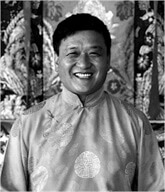
New students now come to Dolanji mostly from the Bonpo monasteries of northwestern Nepal. The settlement also has a primary school for the boys and girls of the village.
Lopon Namdak has recently founded a Bonpo Education Centre in Kathmandu. It is entirely sponsored by Tibetans living in Nepal and receives no official help. The Education Center now has all the necessary buildings ready, but otherwise very little means of support. Lopon himself divides his time between Dolanji and the new school in Kathmandu.
Teaching the Bön Tradition in the West
In 1989, Lopon Tenzin Namdak spent five months traveling in the Western world giving teachings on Dzogchen in England, in the USA and at Merigar, Italy.
You western people are so easy to teach, you always say 'yes' to everything,
said Lopon Namdak, bursting into the joyful laughter that is so typical of him.
Many things have changed in Europe [in the past twenty-five years], including people's attitude toward religion, he said.
When I was in England during the sixties, nobody was interested in the teaching.
Lopon Tenzin Namdak taught in New York City at Madison Square Garden on October 11, 1991, on the Nature of Mind. This teaching was one in a series given prior to the Kalachakra Initiation by preeminent lamas representing each of the five Tibetan traditions.

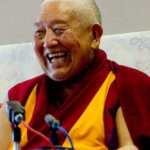
![Dereck Camacho [CC BY-SA 4.0 (https://creativecommons.org/licenses/by-sa/4.0)] Lopon_Tenzin_Namdak_Rinpoche photo by Dereck Camacho](/wp/wp-content/uploads/2017/03/Lopon_Tenzin_Namdak_Rimpoche_Wiki-commons_attr.-Dereck-Camacho-221x300.jpg)
